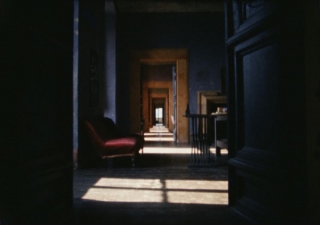Date: 6 April 2015 | Season: Gregory Markopoulos: Film as Film | Tags: Gregory Markopoulos
GREGORY J. MARKOPOULOS: FILM AS FILM
Monday 6 April 2015, at 8:30pm
Los Angeles REDCAT
A great figure of American independent cinema, Gregory J. Markopoulos (1928–1992) made some of the key films of the postwar avant-garde. Poetic, romantic and formally rigorous, his work was deeply rooted in mythological associations and the ritual dimensions of cinema. Despite Markopoulos’ huge influence as a filmmaker and polemicist in the new American Cinema of the 1960s, his films have been largely unavailable until now. The program this evening includes Bliss and Gammelion, which are among the first films made by Markopoulos after he left the U.S. for Europe and represent a major step toward the epic form of his 80-hour magnum opus, Eniaios. —Steve Anker
Gregory J. Markopoulos, Bliss, 1967, 6 min
Gregory J. Markopoulos, Gammelion, 1967, 54 min
This screening celebrates the publication of Film as Film: The Collected Writings of Gregory J. Markopoulos, edited by Mark Webber with a foreword by P. Adams Sitney, published by The Visible Press, London.
PROGRAMME NOTES
SECONDS OF ETERNITY: THE FILMS OF GREGORY J. MARKOPOULOS PROGRAM 1
Monday 6 April 2015, at 8:30pm
Los Angeles REDCAT
BLISS
Gregory J. Markopoulos, US/Greece, 1967, 16mm, color, silent, 6 min
Bliss was the first film Markopoulos made after relocating to Europe. This exquisite portrait of the interior of a Byzantine church on the island of Hydra was composed in-camera in the moment of filming.
GAMMELION
Gregory J. Markopoulos, US/Italy, 1967, 16mm, color, sound, 54 min
Markopoulos’ elegant film of the castle of Roccasinibalda in Rieti, Italy, (then owned by patron, publisher and activist Caresse Crosby) employs an intricate system of fades to extend six minutes of footage to an hour of viewing time. This inventive new film form, in which brief images appear amongst measures of black and clear frames, was a crucial step towards Markopoulos’ final work Eniaios (1947-91). Though seemingly an abstract architectural study, Gammelion is based on Julien Gracq’s surrealist novel Chateau d’Argol, and incorporates elements found at the site to represent the characters and events of the book’s narrative.
“Fortunate is the filmmaker who possesses a daemon, and who passes naturally from season to season, always with renewed energies, to that crucial point where he is able to recognize what constitutes the sunken attitudes of his art; what constitutes the portent, eagle-shaped attitudes. Attitudes which in a season of plenty soar beyond the frailties and grievances of the creative personality. Forgotten and released are the self-acknowledged limitations, the often comical, continuous demands upon friends and acquaintances in the name of one’s art. Finally, the total illusion that has been inherent from the beginning in one’s striving shimmers, quivers, and sets one aflame.” —Gregory J. Markopoulos, Correspondences of Smell and Visuals, 1967
Back to top
